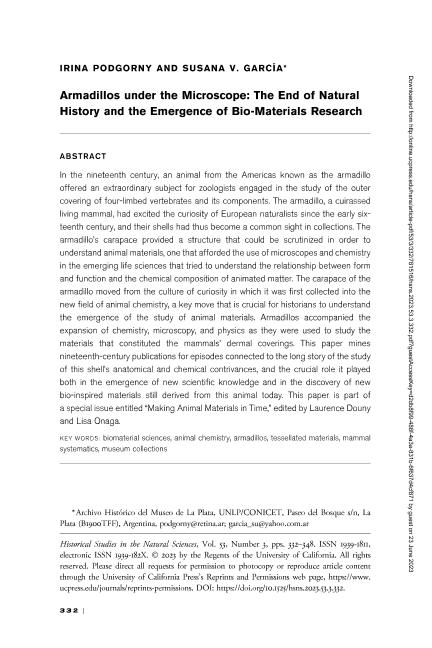Artículo
Armadillos under the Microscope: The End of Natural History and the Emergence of Bio-Materials Research
Fecha de publicación:
06/2023
Editorial:
Univ California Press
Revista:
Historical Studies In The Natural Sciences
ISSN:
1939-1811
Idioma:
Inglés
Tipo de recurso:
Artículo publicado
Clasificación temática:
Resumen
In the nineteenth century, an animal from the Americas known as the armadillo offered an extraordinary subject for zoologists engaged in the study of the outer covering of four-limbed vertebrates and its components. The armadillo, a cuirassed living mammal, had excited the curiosity of European naturalists since the early sixteenth century, and their shells had thus become a common sight in collections. The armadillo’s carapace provided a structure that could be scrutinized in order to understand animal materials, one that afforded the use of microscopes and chemistry in the emerging life sciences that tried to understand the relationship between form and function and the chemical composition of animated matter. The carapace of the armadillo moved from the culture of curiosity in which it was first collected into the new field of animal chemistry, a key move that is crucial for historians to understand the emergence of the study of animal materials. Armadillos accompanied the expansion of chemistry, microscopy, and physics as they were used to study the materials that constituted the mammals’ dermal coverings. This paper mines nineteenth-century publications for episodes connected to the long story of the study of this shell’s anatomical and chemical contrivances, and the crucial role it played both in the emergence of new scientific knowledge and in the discovery of new bio-inspired materials still derived from this animal today. This paper is part of a special issue entitled “Making Animal Materials in Time,” edited by Laurence Douny and Lisa Onaga.
Archivos asociados
Licencia
Identificadores
Colecciones
Articulos(CCT - LA PLATA)
Articulos de CTRO.CIENTIFICO TECNOL.CONICET - LA PLATA
Articulos de CTRO.CIENTIFICO TECNOL.CONICET - LA PLATA
Citación
Podgorny, Irina; García, Susana Valeria; Armadillos under the Microscope: The End of Natural History and the Emergence of Bio-Materials Research; Univ California Press; Historical Studies In The Natural Sciences; 53; 3; 6-2023; 332-348
Compartir
Altmétricas




